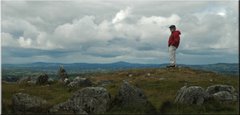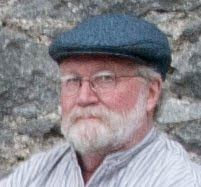Day 28 of 35: Tuesday, August 31, 2010
 We set out nice and early (but not uncivilizedly so) from the airport hotel to re-visit our friends the cows along the banks of the River Boyne. As long as we were there, we decided to nose around a part of the area’s megalithic wonders that we hadn’t seen four years ago.
We set out nice and early (but not uncivilizedly so) from the airport hotel to re-visit our friends the cows along the banks of the River Boyne. As long as we were there, we decided to nose around a part of the area’s megalithic wonders that we hadn’t seen four years ago.
 OPW shuttle bus at the Brú na Bóinne site. Despite its destination sign, it's at the staging area for Knowth.
OPW shuttle bus at the Brú na Bóinne site. Despite its destination sign, it's at the staging area for Knowth.
In 2006 we toured the largest of the 5,000-year-old passage tombs, Newgrange. This time, we took the blue OPW shuttle bus from the Visitors' Centre to the more distant Knowth cluster of mounds, including the largest and highest one, which you can see a bit of in the top photo on this post.
 The passage tombs have been restored to various stages, allowing visitors to see the inner structure of some and the likely working appearance of others. The largest tumulus has two long passages toward chambers near its center (unlike Newgrange, which has one) aligned due east and west (the Newgrange passage is aligned with the winter solstice sunrise point instead). The outer end of the eastern passage can be viewed from a small room near its end, but the passage itself is off-limits to visitors.
The passage tombs have been restored to various stages, allowing visitors to see the inner structure of some and the likely working appearance of others. The largest tumulus has two long passages toward chambers near its center (unlike Newgrange, which has one) aligned due east and west (the Newgrange passage is aligned with the winter solstice sunrise point instead). The outer end of the eastern passage can be viewed from a small room near its end, but the passage itself is off-limits to visitors.
 Ireland's OPW has provided a path to the top of the largest tumulus, not the first time that a subsequent civilization has constructed things atop the builders' artificial hill. Archaeological evidence shows that it has been used many times over the past 5,000 years by different people as a fortress and even the site of a small village.
Ireland's OPW has provided a path to the top of the largest tumulus, not the first time that a subsequent civilization has constructed things atop the builders' artificial hill. Archaeological evidence shows that it has been used many times over the past 5,000 years by different people as a fortress and even the site of a small village.
 At left above, Diane (just to the right of the wood posts, a partial reconstruction of what was probably a ceremonial structure) lends perspective to the size of the large tumulus. The sweeping view from its summit of the Boyne valley is a lovely one; at right we are looking westward along the Boyne.
At left above, Diane (just to the right of the wood posts, a partial reconstruction of what was probably a ceremonial structure) lends perspective to the size of the large tumulus. The sweeping view from its summit of the Boyne valley is a lovely one; at right we are looking westward along the Boyne.
 After our stay at Knowth and the Brú na Bóinne complex, we drove back to Birr along a leisurely route, one designed more for its own sake than for speed. Major highways in Ireland, including the new superhighways, are laid out like spokes radiating from Dublin toward the other relatively large cities on the island. We purposefully worked our way across that plan, traveling an arc across the midlands. Our time in Ireland was dwindling toward its end as August prepared to give way to September, and we were in no rush.
After our stay at Knowth and the Brú na Bóinne complex, we drove back to Birr along a leisurely route, one designed more for its own sake than for speed. Major highways in Ireland, including the new superhighways, are laid out like spokes radiating from Dublin toward the other relatively large cities on the island. We purposefully worked our way across that plan, traveling an arc across the midlands. Our time in Ireland was dwindling toward its end as August prepared to give way to September, and we were in no rush.
==================================
More images of the Knowth complex are available in this slideshow on sharrington.net.
==================================
More images of the Knowth complex are available in this slideshow on sharrington.net.
==================================
Next: September 1, 2010 -- A Midlands Ramble
Previous: August 30, 2010 -- Powerscourt and Howth
Beginning of the series: Prologue, August 2
Previous: August 30, 2010 -- Powerscourt and Howth
Beginning of the series: Prologue, August 2





















































